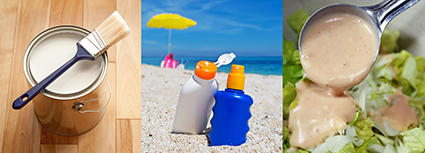
Titanium dioxide nanoparticles are widely used not only in paints but in sunscreen and even salad dressing.
Truth shines a light into dark places. But sometimes to find that truth in the first place, it's better to stay in the dark. That's what recent findings at the National Institute of Standards and Technology (NIST) show about methods for testing the safety of nanoparticles. It turns out that previous tests indicating that some nanoparticles can damage our DNA may have been skewed by inadvertent light exposure in the lab.
Nanoparticles made of titanium dioxide are a common ingredient in paint, and they also are considered safe for use both on the body (in sunscreen, where they help block ultraviolet light) and even within it (in foodstuffs such as salad dressings to make them appear whiter). It is well known that in the presence of light and water, these particles can form dangerous, highly reactive chemicals called free radicals that can damage DNA. Because light does not reach the human body's interior, scientists have long accepted that these nanoparticles would not damage cells by forming free radicals from light activation.
However, some recent studies using cells suggest that titanium dioxide can damage DNA even in darkness—a disturbing possibility. Because such findings could have major health implications, the NIST team set out to determine whether light was indeed required for the nanoparticles to cause DNA damage.
"We didn't set out to test the safety of the particles themselves—that's for someone else to determine," says NIST's Elijah Petersen. "Our main concern is to ensure that scientists have enough knowledge to make accurate measurements. That way, tests will give accurate representations of reality."
The NIST team exposed samples of DNA to titanium dioxide nanoparticles under three different conditions: Some samples were exposed in the presence of visible or ultraviolet light while others were kept carefully and intentionally in complete darkness from the moment of exposure to the time the DNA damage was measured. The team found that only when exposed to laboratory or ultraviolet light did the DNA form base lesions, a form of DNA damage associated with attack by radicals. Their conclusion? The culprit in earlier studies may be ambient light from the laboratory that inadvertently caused DNA damage.
"The results suggest that titanium dioxide nanoparticles do not damage DNA when kept in the dark," Petersen says. "These findings show that experimental conditions, such as lighting, must be carefully controlled before drawing conclusions about nanoparticle effects on DNA."
E.J. Petersen, V. Reipa, S.S. Watson, D.L. Stanley, S.A Rabb and B.C. Nelson. The DNA damaging potential of photoactivated P25 titanium dioxide nanoparticles. Chemical Research in Toxicology, October 2014 issue, DOI: 10.1021/tx500340v.

